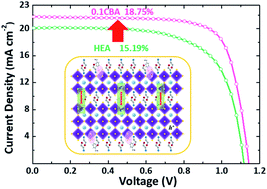Passivation effect of halogenated benzylammonium as a second spacer cation for improved photovoltaic performance of quasi-2D perovskite solar cells†
Abstract
The low photovoltaic performance of 2D perovskites, which is caused by high exciton binding energy and wide band gaps, has limited their further development and applications. Here, we adopted a new-type strategy to obtain high-quality 2-hydroxyethylamine (HEA)-based quasi-2D perovskite films by incorporating halogenated second spacer cations. Due to the effective passivation of halogenated benzylammonium cations with enhanced electronegativity, the mixed quasi-2D perovskites displayed superior crystallinity and reduced internal defects, leading to an enhanced charge transfer and suppressive carrier recombination. As a result, significantly improved power conversion efficiency (PCE) from 15.19% to 18.75% with an enhanced open-circuit voltage (Voc) and fill factor (FF) was achieved. After aging at 85 °C for 200 h and 45 ± 5% relative humidity (RH) for 1500 h, the unencapsulated optimal devices retained 81% and 90% of the initial PCE, respectively. Our study provides an effective and simple strategy to improve the photovoltaic performance and environmental stability of 2D perovskites for commercial applications.



 Please wait while we load your content...
Please wait while we load your content...